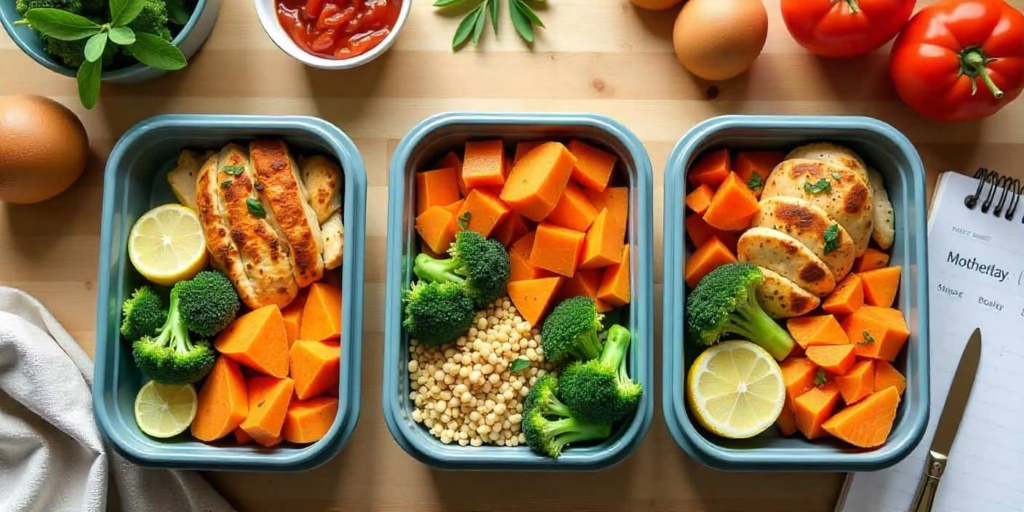Introduction
Staying fit and eating clean doesn’t have to mean spending a fortune on groceries or devoting hours each day to cooking. In fact, with the right strategy, you can build an effective and nutritious diet that supports your fitness goals—without blowing your budget or overwhelming your schedule. Whether you’re juggling a 9–5 job, kids, or both, this guide will walk you through budget meal planning for fitness so you can fuel your body efficiently, affordably, and consistently.
Why Meal Planning Is Essential for Fitness
When it comes to fitness, nutrition is half the battle. No matter how well you train, progress can stall if your diet lacks consistency or proper nutrients. That’s where meal planning becomes a game-changer. Planning meals ahead saves time, eliminates impulsive eating, helps control portion sizes, and keeps you aligned with your calorie and macro goals. For busy professionals, it removes daily decision fatigue and helps you stay focused on work and workouts alike.
Benefits of Budget Meal Planning for Fitness
One of the biggest misconceptions is that healthy eating is expensive. While it can be if you’re relying on prepackaged health foods or trendy superfoods, real nutrition can be both simple and affordable. With a little preparation, budget meal planning allows you to:
- Control your portion sizes and caloric intake
- Save money by avoiding takeout or convenience meals
- Prevent food waste through better grocery planning
- Reduce stress around daily food decisions
- Stick to a diet that supports fat loss, muscle gain, or maintenance goals
If you’re unsure about your calorie targets, try our free BMI & Calorie Calculator to get started.
Step-by-Step Budget Meal Planning for Fitness
1. Start with a Weekly Meal Plan Template
Begin by creating a simple plan for your breakfasts, lunches, dinners, and snacks. Use a template or printable planner to organize your meals across the week. Repeating certain meals for 2–3 days can reduce cost and prep time significantly. Keep it simple with 2–3 options per meal category.
2. Set a Realistic Grocery Budget
Decide how much you’re willing to spend each week. For most single individuals, $30–$50 per week is realistic for meal-prepped, clean eating. If you’re feeding a family or bulking, you may need to adjust. Apps like Mealime or Paprika can help track grocery costs while planning.
3. Build Meals Around Affordable Protein Sources
Protein is essential for muscle repair and satiety, but it can also be pricey. To stay within budget, rely on:
- Eggs and egg whites
- Canned tuna or sardines
- Skinless chicken thighs or drumsticks
- Frozen turkey or lean ground beef
- Greek yogurt (plain, nonfat)
- Plant-based proteins like lentils, chickpeas, and tofu
Combining animal and plant proteins helps you hit your macro goals without overspending. You can explore more protein strategies in our article on Nutrition for Strength Training.
4. Buy in Bulk and Freeze
Buying large quantities of meat, rice, oats, and frozen veggies in bulk can save up to 30–40% compared to small packs. Invest in freezer-safe containers and zip bags to portion and freeze meals ahead of time. This not only saves money but also makes eating clean almost automatic during busy weeks.
5. Cook in Batches
Batch cooking is the secret weapon for busy professionals. Pick two days each week (e.g., Sunday and Wednesday) to cook 2–3 proteins, a grain, and several veggies. Combine these in different ways to create meals that don’t get boring. For example:
- Grilled chicken + rice + broccoli
- Turkey chili with beans and brown rice
- Stir-fried tofu with mixed frozen vegetables and quinoa
Once portioned, store your meals in stackable containers and label them by day for grab-and-go convenience.
6. Use Budget-Friendly Staples
Base your grocery list around affordable, nutrient-dense staples such as:
- Brown rice, quinoa, oats
- Sweet potatoes, white potatoes
- Beans, lentils
- Frozen vegetables and fruits
- Peanut butter and natural nut butters (in moderation)
These items offer high satiety, great nutrition, and long shelf lives—ideal for consistent clean eating without waste.
7. Shop Smart
Stick to your grocery list and avoid impulse buys. Consider:
- Shopping at discount grocers (e.g., Aldi, Lidl)
- Using loyalty cards and cash-back apps
- Buying store brands instead of name brands
- Planning meals around weekly deals and sales flyers
Apps like Flipp and Ibotta can help you stay within budget while maximizing your nutritional return on investment.
8. Keep It Simple, Not Perfect
You don’t need fancy ingredients or Instagram-worthy plating. Focus on nutrient density, not aesthetics. The simpler your meal prep is, the more likely you’ll stay consistent—and consistency is where results come from. If you’re aiming for fat loss, pairing your meal plan with simple training like HIIT vs Strength Training can amplify results without extra cost.

Sample 3-Day Budget Meal Plan
Day 1: Start your morning with oatmeal topped with banana and peanut butter. For lunch, enjoy a tuna salad paired with brown rice and steamed carrots. Dinner features baked chicken thighs with sweet potato and green beans. Round off the day with Greek yogurt and frozen berries as a snack.
Day 2: Kick off with scrambled eggs, toast, and fruit. Midday, a hearty lentil curry served with quinoa and frozen spinach fuels your energy. A bowl of turkey chili with kidney beans and rice makes a satisfying dinner. A protein shake blended with oats and almond butter keeps hunger at bay between meals.
Day 3: Begin with overnight oats mixed with chia seeds and apple slices. Tofu stir-fried with mixed vegetables and noodles is your lunch go-to. Enjoy baked fish with mashed potatoes and peas in the evening. Snack on cottage cheese and pineapple for a light, protein-rich option.
This kind of rotation keeps costs low, prep time minimal, and nutrition high.
Common Mistakes to Avoid
- Overcomplicating meals: Stick to simple ingredients and prep-friendly recipes
- Ignoring portion sizes: Overeating even clean foods adds up
- Skipping snacks: Balanced snacking keeps energy stable
- Not planning enough variety: A little rotation avoids burnout
- Buying too much fresh produce: Stick to what you’ll realistically eat or freeze
Conclusion
Budget meal planning for fitness is not only possible—it’s one of the smartest strategies for busy professionals trying to live healthier lives. With some planning, bulk shopping, and batch cooking, you can eat clean, fuel your workouts, and hit your fitness goals without overspending. Remember, success comes from consistency, not complexity. 👉 Ready to level up your fitness journey? Check out our latest article on Meal Planning 101: Save Time, Eat Healthy to build your clean eating strategy from the ground up.


